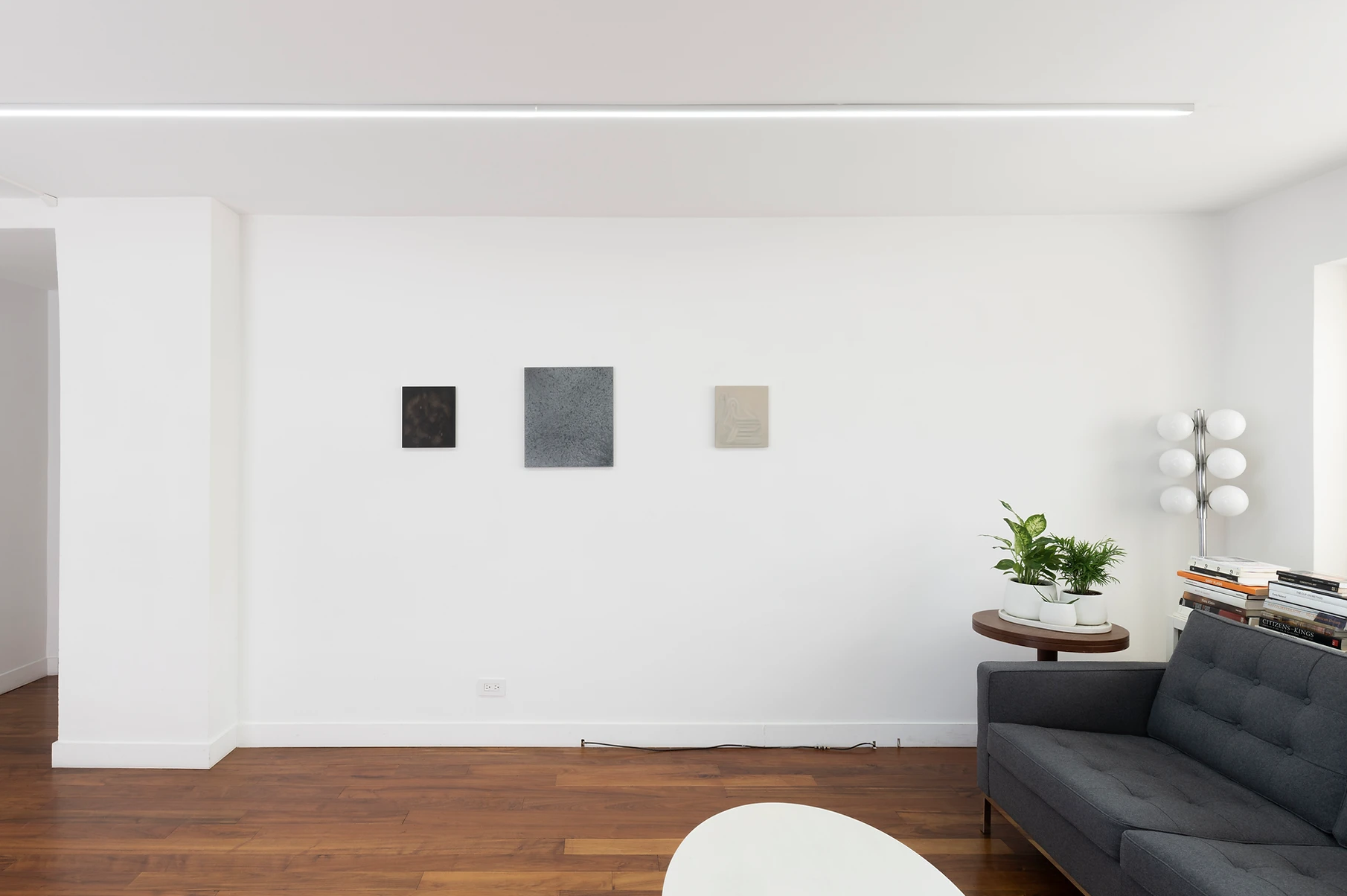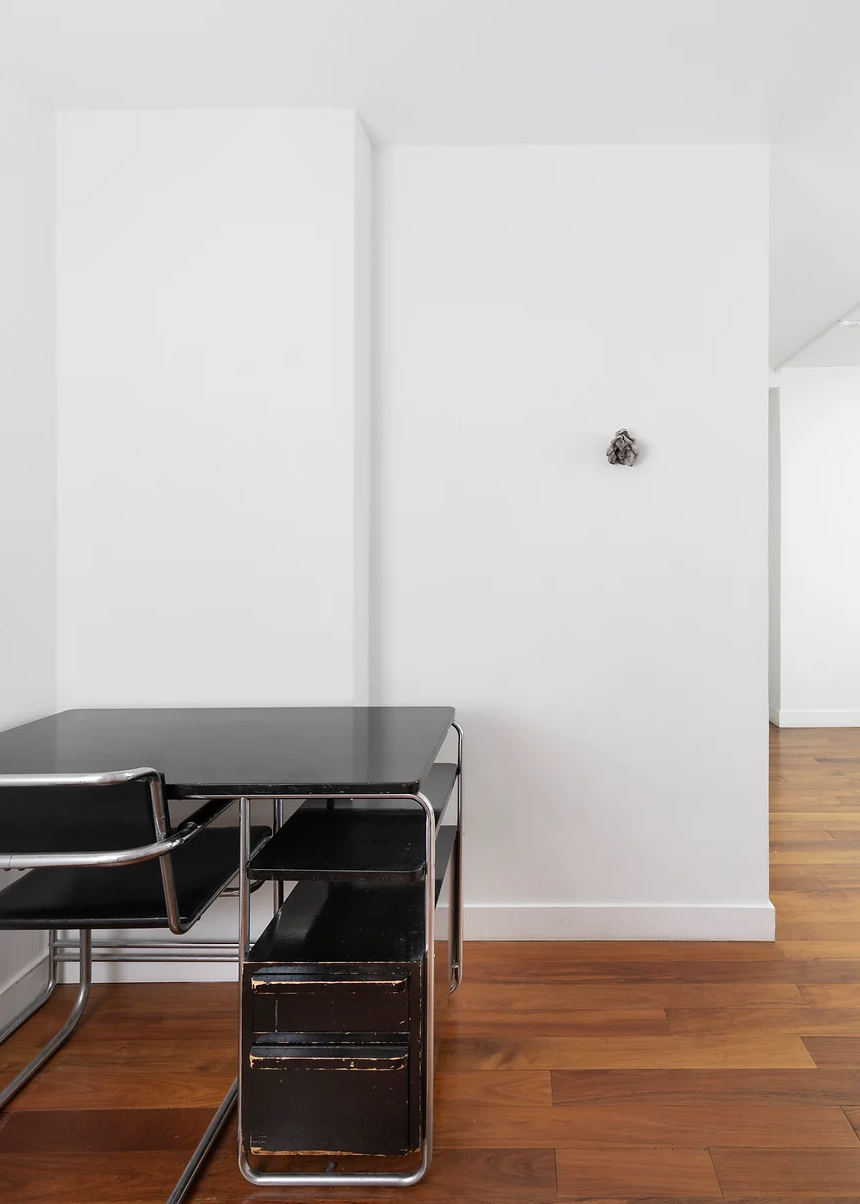The Oft and the Howl
The Meeting - NYC
May 2022
Press Release:
The nine works in Andrew Chapman’s The Oft and the Howl all seem to come from somewhere else. A surprising indifference to the demands of both the market and art history to develop a recognizable individual style, this puzzle of variety plays off against the modest scale of the work. It comes across almost like a model of the profusion and polysemy of painting, in the same moment emphasizing breadth and drawing the viewer close.
The pleasures and problems of painting are inevitably caught up with the medium’s histories, which seem always to haunt its present. Although a few of the works here vaguely evoke antecedents from the history of abstraction—machine age modernism (Dragon’s World Limited 1979), Ferus Gallery California cool (Bit Que)—such likenesses are fleeting—just as in Split Tint with Pink Noise the impression of figuration tantalizes and recedes. Chapman for the most part eschews any discernible form of painterly mark-making, pursuing instead a series of mesmerizing—if often unplaceable—surface effects. And although the surfaces invite and reward close scrutiny, Chapman covers his tracks, obscuring hints of process. Many don’t even read obviously as painting: the lone sculpture-like work, Wyatt, appears like a peculiar fake rock, while works such as Leadpri, MG.5, and Pet Sounds are suspended between painting and image.
These anonymizing tactics help reorient the logic of abstraction in the age of image excess. A grid jumps out from among Chapman’s disparate compositions because the grid as a form has a special place in twentieth-century art. If in 1979 Rosalind Krauss could claim that the grid had been “almost totally successful in walling the visual arts into a realm of exclusive visuality and defending them against the intrusion of speech,” the extensive literature that it generated (to which her essay is probably the best-known addition) now clings to this thoroughly historicized form.[1] It is covered in the very language it allegedly sought to wall off. Chapman’s grid, V_4.9, with a surface so pristine as to banish the very thought of a human hand, tilts instead toward the surrounding works and the perceptual relations that emerge between them. In this, he captures something essential about the very different mode of abstraction inherent to image circulation—the endless flow of disparate and decontextualized sights. And yet nothing could seem further in tempo and tone than these meticulous, obsessive, and enigmatic paintings.
Andrew Chapman was born in San Francisco and works and resides in Los Angeles, California. He received his MFA from Stanford University and his BFA from California College of the Arts in San Francisco, CA. Chapman’s work, largely rooted in painting, deals with the act of image making through varied and meticulous means. His approach to abstraction belies the realism of representation. While simultaneously describing an idiosyncratic breadth of subject matter and surfaces with uncanny familiarity, the works reside on the periphery of what may be deemed ‘of this world’.
He has shown work at several galleries and educational institutions including solo shows at Et al. and California College of the Arts in San Francisco. Group exhibitions include Petra Pibeau, New York, Daniela Elbahara, Mexico City, Portmanteau, Geneva, Switzerland, Yerbea Buena Center for the Arts, and The Popular Workshop, San Francisco. He was awarded the Peter S. Reed Foundation Individual Artist Grant and Jack & Gertrude Murphy Fellowship and the Edwin Anthony & Adelaine Bordeaux Cadogan Fellowship in the Fine Arts.
Text by Eli Diner
[1] Rosalind Krauss, “Grids,” October 9 (Summer, 1979), 50.
The Meeting - NYC
May 2022
Press Release:
The nine works in Andrew Chapman’s The Oft and the Howl all seem to come from somewhere else. A surprising indifference to the demands of both the market and art history to develop a recognizable individual style, this puzzle of variety plays off against the modest scale of the work. It comes across almost like a model of the profusion and polysemy of painting, in the same moment emphasizing breadth and drawing the viewer close.
The pleasures and problems of painting are inevitably caught up with the medium’s histories, which seem always to haunt its present. Although a few of the works here vaguely evoke antecedents from the history of abstraction—machine age modernism (Dragon’s World Limited 1979), Ferus Gallery California cool (Bit Que)—such likenesses are fleeting—just as in Split Tint with Pink Noise the impression of figuration tantalizes and recedes. Chapman for the most part eschews any discernible form of painterly mark-making, pursuing instead a series of mesmerizing—if often unplaceable—surface effects. And although the surfaces invite and reward close scrutiny, Chapman covers his tracks, obscuring hints of process. Many don’t even read obviously as painting: the lone sculpture-like work, Wyatt, appears like a peculiar fake rock, while works such as Leadpri, MG.5, and Pet Sounds are suspended between painting and image.
These anonymizing tactics help reorient the logic of abstraction in the age of image excess. A grid jumps out from among Chapman’s disparate compositions because the grid as a form has a special place in twentieth-century art. If in 1979 Rosalind Krauss could claim that the grid had been “almost totally successful in walling the visual arts into a realm of exclusive visuality and defending them against the intrusion of speech,” the extensive literature that it generated (to which her essay is probably the best-known addition) now clings to this thoroughly historicized form.[1] It is covered in the very language it allegedly sought to wall off. Chapman’s grid, V_4.9, with a surface so pristine as to banish the very thought of a human hand, tilts instead toward the surrounding works and the perceptual relations that emerge between them. In this, he captures something essential about the very different mode of abstraction inherent to image circulation—the endless flow of disparate and decontextualized sights. And yet nothing could seem further in tempo and tone than these meticulous, obsessive, and enigmatic paintings.
Andrew Chapman was born in San Francisco and works and resides in Los Angeles, California. He received his MFA from Stanford University and his BFA from California College of the Arts in San Francisco, CA. Chapman’s work, largely rooted in painting, deals with the act of image making through varied and meticulous means. His approach to abstraction belies the realism of representation. While simultaneously describing an idiosyncratic breadth of subject matter and surfaces with uncanny familiarity, the works reside on the periphery of what may be deemed ‘of this world’.
He has shown work at several galleries and educational institutions including solo shows at Et al. and California College of the Arts in San Francisco. Group exhibitions include Petra Pibeau, New York, Daniela Elbahara, Mexico City, Portmanteau, Geneva, Switzerland, Yerbea Buena Center for the Arts, and The Popular Workshop, San Francisco. He was awarded the Peter S. Reed Foundation Individual Artist Grant and Jack & Gertrude Murphy Fellowship and the Edwin Anthony & Adelaine Bordeaux Cadogan Fellowship in the Fine Arts.
Text by Eli Diner
[1] Rosalind Krauss, “Grids,” October 9 (Summer, 1979), 50.




